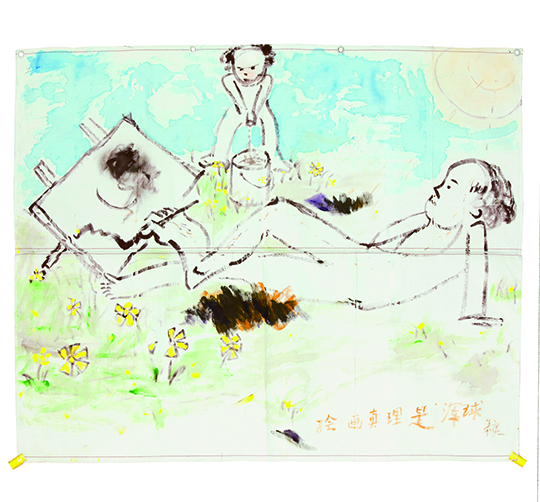LIAO GUOHE: BANANAS, EGGPLANTS, MEAT PATTIES
| October 14, 2013 | Post In LEAP 23

Asshole, 2013
Acrylic on canvas, 180 x 220 cm
My curiosity in Liao Guohe started from his CV. He was born in Calcutta in 1977, studied mechanical drawing in the United States, and now lives in Hunan. Before World War II, about 20,000 Chinese fled to Calcutta; by the end of the Sino-Indian War in 1962 this population was down to a cool 7,000 (mostly Cantonese). That among this group of people there would be born a Chinese who goes to live in a second-tier city in the interior of China and pursue a career in contemporary Chinese art, simply put, seems to defy logic.
When I read this résumé, too good to be true, I felt as though I had picked up a work of absurdist fiction.
In 2009, Liao Guohe came onto the scene with a misleadingly-titled solo exhibition: “‘Quietly Appeared Commercial Salon, i.e. Useless King on the Shore of the Fools’ Wu Shanzhuan, Wang Xingwei and Liao Guohe Creation Selling Exhibition.” Moreover, he showed a number of signs of “bad” painting: patched clothing, unkempt hair, coarse body hair, scribbled writing, and clashing colors… some people labeled this betrayal of traditional painterly form “pushing painting into the corner.”
Unusual marks are visually stimulating and the “rebellious” path livens up the dull art gallery scene. In the past few decades of artistic practice this desire has been turned into a strategy for artistic production and curating, and has been widely welcomed. But even though the intention was good, its actual effect on the art world is now being brought into question.
So, what sort of belief system motivates the makers of bad art?
Visiting this exhibition, a number of key words sound in my head like a repeating audio guide: “low-class worker,” “poor taste,” “simple, unrefined.” But as Liao Guohe persists in employing text, the written word held greater sway. One-third of the works involve the word “justice”: a rooster spits it out, a group of migrating birds form the shape of the characters in their flight, and justice is branded on the side of a man’s face, and also on the tongue of a woman… the canvases are loaded with satire, tears, and absurdity. The overall effect is crude and vulgar.
Yet Liao Guohe’s paintings are more than just bad art. He not only shows his skill in color harmony, he also excels at capturing a subject’s spirit with simple marks. These all have a pleasing visual rhythm, be they made with spray paint, smoothly applied, or coughed up in rough brushstrokes on industrial-grade linen. At the same time, he concentrates on the action in the composition. In those normal and humorous scenes one detects a careful observation of life, and bold conclusion. It is the same as in traditional Chinese painting, which emphasizes the appreciation and manipulation of the aesthetic perspectives between society, nature, and mankind.
However, it feels as though the artist and the gallery do not want us to see this: “Liao experiments with industrial linen cloths…” or “Liao’s works focus to deliver a message…” Compared to formal aesthetic standards, contemporary art only rewards a rebellious attitude. Rebellion itself can easily become the defining characteristic of an artist’s practice.
In looking for the new and different, if you follow familiar knowledge constructs, minor “breakthroughs” only serve to make our thinking even more conservative. If we only rely on conceptual vocabulary, and do not think by observation, our conscious mind finds it hard to open up to new realities. Liao Guohe’s paintings expose a simple rumination over life, and their being pleasant is enough.
I have never encountered the truly outstanding Liao Guohe. Any effect on the senses his work may have, however earth-shattering or thought-provoking, is still produced by following the rules of the game, because we are all caught up in the system; maybe Liao Guohe is actually living humbly in the machine of society just like the rest of us, and I have encountered him without knowing it.
Maybe there really is an absurdist novel about an Indian-born Chinese who studies in America, comes to rural China, and struggles to became a contemporary artist— but when I read the beginning I cannot guess the ending. (Translated by Vanessa Nolan)

